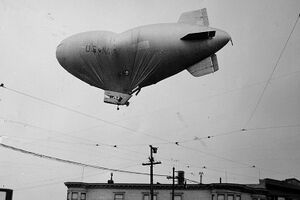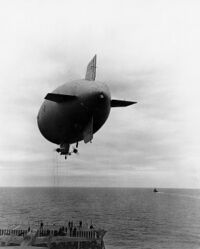Engineering:L-8
 The derelict L-8, floating over San Francisco after the disappearance of its crew. | |
| Occurrence | |
|---|---|
| Date | 16 August 1942; 81 years, 11 months ago |
| Summary | Cause unknown, aircraft recovered |
| Site | Pacific Ocean, off the coast of San Francisco , California , U.S. |
| Aircraft | |
| Aircraft type | L-class blimp |
| Operator | |
| Registration | L-8 |
| Flight origin | Treasure Island, San Francisco, California, U.S. |
| Destination | Treasure Island, San Francisco, California, U.S. |
| Occupants | 2 |
| Passengers | 0 |
| Crew | 2 |
| Fatalities | 2 (presumed) |
| Survivors | 0 (presumed) |
L-8, later renamed America and popularly known as the "Ghost Blimp", was a United States Navy L-class airship whose crew disappeared over the Pacific Ocean on August 16, 1942. At 11:15 a.m., several hours after the airship lifted off from Treasure Island, San Francisco , California , L-8 reappeared off the shore of Ocean Beach near Fort Funston. L-8 briefly made contact with the ground at Ocean Beach, causing damage to the airship, then drifted over San Francisco and crashed on Bellevue Avenue, Daly City. No traces of its crewmen, Lieutenant Ernest DeWitt Cody and Ensign Charles Adams, have ever been found.
Background
The L-class was a series of non-rigid airships (blimps), produced for the United States Navy in 1937, based upon the small commercial airships produced by the Goodyear Aircraft Company that were used for advertising Goodyear tires.
After the United States declared war on Japan in response to Pearl Harbor, the Imperial Japanese Navy sank at least half a dozen Allied ships off of the West Coast over a period of several months.[1] By August 1942, the Japanese had bombed Ellwood Oil Field in California and Fort Stevens in Oregon. Heightened fears of an invasion had also prompted the Battle of Los Angeles in which a false alarm was raised over what later was determined to be a weather balloon.[2]
One of the responses by the Navy included a takeover of Goodyear's five-airship fleet, operating them out of the Navy's two major lighter-than-air bases in Lakehurst, New Jersey and Moffett Field in California.[3] These Goodyear blimps were incorporated into an "L-class" with designations L-4 through L-8. While they were too small for any extensive operational use, the blimps were considered ideal for training missions and coastal antisubmarine patrols.[1][4]
Sources differ as to whether L-8 had been named Rainbow or Ranger prior to its Navy service[n 1]. Several months prior to the incident, in April 1942, L-8 delivered vital B-25 modification parts to the aircraft carrier USS Hornet (CV-8) after she departed California carrying the Doolittle Raiders, ahead of their assault on Tokyo.[5]
Incident

At 6:03 a.m., on August 16, 1942, L-8 – having been assigned to Airship Patrol Squadron 32 – lifted off from Treasure Island, San Francisco , on a coastal antisubmarine patrol. Its scheduled route would have taken the airship over the Farallon Islands, Point Reyes, and the locality of Montara before circling back towards the Golden Gate Bridge. Inside the gondola were Lieutenant Ernest DeWitt Cody, aged 27, and his co-pilot, Ensign Charles Adams, aged 35; it was Adams's first flight as a commissioned officer.[6] L-8 was armed with two depth charges and one .30-caliber machine gun. At the time of the incident, the airship had made 1,092 previous trips without incident and had recently been inspected. Conditions on the morning of the flight were clear.[3]
At 7:38 a.m., L-8's crew radioed to Treasure Island and reported observing an oil slick four miles off the coast of the Farallon Islands. A Liberty ship and a fishing boat in the area both witnessed L-8 descending to within thirty feet of the ocean surface and circling the oil slick. This would constitute the last confirmed sighting of the airship with the crew aboard. Controllers at Treasure Island lost contact with the crew at 8:50 a.m.[6] Shortly after 9:00 a.m., L-8 dumped ballast, ascended, and headed east – contrary to its intended course towards Point Reyes, which was to the northwest.[3]
At 11:15 a.m., L-8 reappeared off the coast of Ocean Beach and drifted towards the coastline at low elevation. The airship touched down on the beach, where two surf fishermen tried to hold it down by its tie lines. Upon looking inside the gondola, the fishermen observed that no crew were inside. As the fishermen were unable to hold the airship down any longer, it rose briefly into the air before running into a sloping cliff, causing damage to its starboard propeller and dislodging one depth charge, relieving it of enough weight to gain altitude.[7] An automatic valve inside L-8 was opened and began releasing helium gas, causing the airship to take a sagging, V-shaped appearance as it deflated.[6] L-8 drifted inland over the Olympic Club golf course and Mission Street, attracting the attention of a large crowd of onlookers who followed its journey. Floating over San Francisco's Crocker-Amazon neighborhood, the airship lost elevation and began scraping telephone poles and residential houses. L-8 finally crashed in front of a house at 419 Bellevue Avenue, Daly City.[3]
Investigation
Police and military personnel immediately descended upon the crash site. While the gondola doors were found hanging open, and the crash had been so gentle that the crewmen would have walked away unharmed, neither Cody nor Adams were found inside. Searches of the coastline from air, land and sea found no trace of the missing pilots, and the search was abandoned on August 18.[8] Authorities initially theorized that Cody and Adams had bailed out of L-8 over the ocean, but all three parachutes and a rubber life raft were found aboard the gondola. Furthermore, the airship's radio and engines were switched on and no distress transmissions had been sent, indicating that the crewmen's disappearance had been abrupt. A board of investigation convened by the Navy could only determine that L-8 had not been shot down, burned, or made contact with the ocean, and that Cody and Adams had not engaged in misconduct. Cody and Adams were declared legally dead in 1943.[3][6]
The official theory was that in order to deploy a smoke marker at the site of the oil slick, one crew member had opened the rear hatch of the gondola. He then slipped and, dangling from the hatch, shouted for assistance. When the other crew member attempted rescue, they both fell. The sudden loss of weight would have caused the derelict airship to rapidly gain altitude.[7] Outside of official circles, various scenarios were immediately put forward attempting to explain Cody and Adams's disappearances and the circumstances of L-8's mysterious flight. This included speculation that the crewmen had either been captured or defected to Japan; that their disappearance was the result of a desertion scheme gone awry; or other more outlandish scenarios.[3]
Aftermath
L-8 was quickly repaired and returned to service following the incident. After the war, the airship was sold back to the Goodyear company and renamed America, flying over sporting events as part of Goodyear's blimp fleet until it was retired in 1982.[3] Its gondola was then repainted back to its L-8 markings and given to the National Naval Aviation Museum in Pensacola, Florida, where it sits on static display.[5][9]
See also
- List of people who disappeared mysteriously at sea
- US Navy airships during World War II
- List of missing aircraft
Notes
- ↑ This website claims that the blimp had previously been named Ranger, while this online history of Airship Patrol Squadron 32 claims it had been named Rainbow.
References
- ↑ 1.0 1.1 John J. Geoghegan (April 12, 2016). "Mystery of the Ghost Blimp". History.net. http://www.historynet.com/mystery-of-the-ghost-blimp.htm. Retrieved November 20, 2018.
- ↑ Murphy, Col. John G. (May–June 1949). "Activities of The Ninth Army AAA - L.A. "Attacked"". Antiaircraft Journal, the United States Coast Artillery Association LXXXII (3): 5. http://sill-www.army.mil/ada-online/antiaircraft-journal/_docs/1949/5-6/May-June%201949%20Screen.pdf. Retrieved November 20, 2018.
- ↑ 3.0 3.1 3.2 3.3 3.4 3.5 3.6 Gary Kamiya, "Ghost blimp's enduring mystery: How did crew vanish before Bay Area crash?", San Francisco Chronicle, September 29, 2018.
- ↑ Vincent H. Gaddis (1965). Invisible Horizons. Ace Books. p. 185. ISBN 9780801914072. https://books.google.com/books?id=cb4YAQAAMAAJ&q=l-8+blimp+assigned+patrol. Retrieved November 20, 2018.
- ↑ 5.0 5.1 "L-8 Ghost Ship". http://www.navalaviationmuseum.org/attractions/aircraft-exhibits/item/?item=l-8.
- ↑ 6.0 6.1 6.2 6.3 "Crash of the L-8". http://www.check-six.com/Crash_Sites/L-8_crash_site.htm.
- ↑ 7.0 7.1 "The Mystery of the L-8" (in en). 1970-03-01. https://www.usni.org/magazines/proceedings/1970/march/mystery-l-8.
- ↑ "Navy L-8 Blimp Disappears off San Francisco Coast - 1942". http://www.sfmuseum.org/hist8/blimp.html.
- ↑ "L-8 Ghost Ship". www.navalaviationmuseum.org. http://www.navalaviationmuseum.org/attractions/aircraft-exhibits/item/?item=l-8. Retrieved November 20, 2018.
External links

